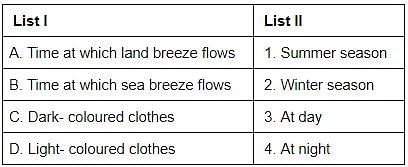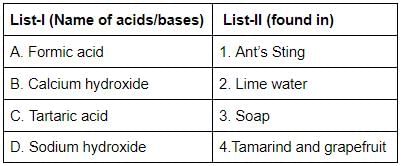Test: Class 7 General Science NCERT Based - 2 - UPSC MCQ
25 Questions MCQ Test Science & Technology for UPSC CSE - Test: Class 7 General Science NCERT Based - 2
Consider the following assertions :
1. The heat flows from a hotter object to a colder object.
2. The mode of heat transfer that continues till the whole water gets heated is known as convection.
3. The process by which heat is transferred from the hotter end to the colder end of an object is known as the conduction.
Which of the above assertions is/are correct?
Match List I to List II and select the correct answer with the code given below:


An iron ball at 40°C is dropped in a mug containing water at 40°C. The heat will
More is the difference in temperature of the bodies in contact:
Which of the following pairs may give equal numerical values of the temperature of a body?
Match List I to List II and select the correct answer with the code given below:

A B C D
(a) 1 2 3 4
(b) 1 2 4 3
(c) 4 3 1 2
(d) 4 3 1 2
Consider the following assertions:
1. The solutions which do not change the colour of either red or blue litmus are known as neutral solutions.
2. Turmeric, litmus, china rose petals are some of the naturally occurring indicators.
3. When acid content is high in rainwater, then it is called acid rain.
Which of the above assertions is/are correct?
Which of the following assertions is/are correct with reference to soil treatment due to excessive use of chemical fertilisers?
1. Excessive use of chemical fertilisers makes the soil acidic.
2. If the soil is acidic, organic matter is added to it.
Use the code given below to select the correct answer :
Regarding the examples of neutralisation in Everyday Life, consider the following assertions :
1. The waste of many factories contain acids; therefore, they are neutralised by adding basic substances before they are allowed to flow into the water bodies.
2. Magnesium hydroxide neutralises the effect of excessive acid in the stomach.
3. The effect of the acid injected into the skin through an ant bite can be neutralised by rubbing moist baking soda (sodium hydrogen carbonate) or calamine solution.
Which of the above assertions is /are correct?
Which of the following examples is/are related to physical change?
1. Tearing of paper
2. Change in color
3. Combining of Hydrogen and Oxygen to form water
4. Burning of paper
Use the code given below to select the correct answer :
In terms of physical and chemical changes, which of the following assertions is/are correct?
1. All physical changes are irreversible, while chemical changes are reversible.
2. The following may accompany a chemical change:-Sound may be produced, Heat, light or any other radiation (ultraviolet, for example) may be given or absorbed.
Use the code given below to select the correct answer :
Which of the following is not a physical change?
Which of the following are exothermic processes?
1. Reaction of water with quicklime
2. Dilution of an acid
3. Evaporation of water
4. Sublimation of camphor (crystals)
The process used to prevent rusting of iron, in which a thin coat of zinc is provided over the iron surface. This process is:
Which statement is correct regarding acids?
1. Acid is a molecule which donate protons or accept electron pairs in reactions.
2. Acid increases the concentration of hydrogen ions or hydronium atoms in water.
3. Acids have pH value less than 7.
4. Acid in the stomach helps in the digestion of food.
Use correct statements:
Regarding the weather and climate, consider the following assertions —
1. The day-to-day condition of the atmosphere at a place with respect to the temperature, humidity, rainfall, wind speed, etc., is called the weather at that place.
2. The average weather pattern taken over a long time, say 30 years, is called the climate of the place.
Which of the above assertions is/are correct?
In the context of polar areas, consider the following assertions :
1. There happens to be six months of day and six months of night.
2. These regions are covered with snow and the temperature can be as low as –37 °C during winters.
3. Polar bears, penguins and reindeer are found here.
4. Many birds migrate to warmer regions when winter sets in.
Which of the above statements is correct?
Which of the following assertions is/are true, in terms of tropical region?
1. The climate of these areas is generally hot.
2. These regions get plenty of rainfall.
3. Tropical rain forests are found in Western Ghats and Assam in India.
4. Lion tailed macaque (also called Beard ape) lives in the rainforests of Western Ghats.
Use the code given below to select the correct answer :
Consider the following assertion and reason carefully:
Assertion: The moving air is called the wind.
Reason: Air moves from the region where the air pressure is high to the region where the pressure is low.
Use the code given below to select the correct answer :
Consider the following assertions :
1. The regions close to the equator get maximum heat from the Sun.
2. The warm air rises, and the cooler air from the regions in the 0-30 degrees latitude belt, moves in the equator from the 30 degree side.
3. Due to the uneven heating of 30° to 60° latitude, the wind flows from 60° latitude to 30° latitude.
Which of the above assertions is/are correct?
In the context of wind flow, which of the following assertions is/are true?
1. In winter, the wind flows from the land to the ocean.
2. In summers, the wind flows from the oceans towards the land.
3. The winds from the oceans carry water vapour and bring rain. It is a part of the water cycle.
Use the code given below to select the correct answer :
Consider the following assertions in the context of thunderstorms and cyclones —
1. The swift movement of the falling water droplets along with the rising air create lightning and sound, is called a thunderstorm.
2. The centre of a cyclone is a calm area.
Which of the above assertions is/are correct?
In the context of cyclones, which of the following assertions is/are correct?
1. The western coast of India is more sensitive than the eastern coast in both strength and frequency of cyclones.
2. It is called a ‘hurricane’ in the American continent. In the Philippines and Japan it is called a 'typhoon'.
Use the code given below to select the correct answer :
Consider the following statement about tropical cyclone
1. It is characterised by a low-pressure centre.
2. In this, counter clockwise wind flow in the Northern Hemisphere and clockwise wind flow in the Southern Hemisphere.
3. It is a warm core storm system.
Which of the above statements are correct?
Consider the following factors causes an increase in salinity of ocean water:
1. High temperature
2. High humidity
3. Pressure of winds
4. Presence of river mouths
Which of the statement(s) given above is/are correct?
|
114 videos|428 docs|209 tests
|


















